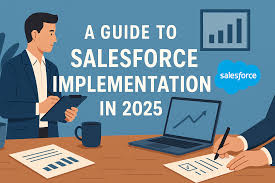In 2025, businesses are increasingly relying on Salesforce consulting in Berlin Germany to improve customer relationships, streamline workflows, and enhance productivity. Partnering with an experienced Salesforce consultant in Berlin Germany helps companies implement customized CRM solutions that align perfectly with their business goals and drive digital transformation
- Why Berlin Businesses Turn to Salesforce Consulting
Berlin’s tech scene moves fast. Companies here use Salesforce consulting to connect better with customers, clean up their workflows, and push their digital transformation forward. A savvy Salesforce consultant in Berlin gets the quirks of the German market and shapes solutions for real results.
Here’s what they bring to the table:
CRM setups that actually fit your business
Sales and service automation that saves your team time
Seamless integration with your existing tools
Live analytics and smart, AI-powered insights
- What a Salesforce Consulting Partner Does in Germany
Having a Salesforce consulting partner in Germany means you’ve got someone bridging the gap between powerful tech and your business goals. They’re there from the planning phase right through to launch, making sure everything runs smoothly and your daily work doesn’t grind to a halt.
They handle:
Digging into your requirements and building a plan
Migrating your data and hooking Salesforce into your current systems
Setting up workflow automations and dashboards
Training your team and sticking around for support
With the right partner in Berlin, you see a faster return and your team gets more done.
- Best Practices for Salesforce Implementation in Germany
Getting Salesforce right isn’t just about flipping a switch. It takes clear goals, good structure, and real teamwork. Here’s what top Salesforce consultants in Berlin recommend:
a. Set Clear Goals
Figure out what success actually looks like for you. Are you after better sales tracking? More leads turning into customers? Sharper customer service? Nail this down before you start.
b. Pick the Right Partner
Choose an experienced Salesforce consulting partner in Germany who knows your industry and can shape the tech around your real-world processes.
c. Get the Team On Board
No CRM works if nobody uses it. Keep your team trained up and listen to their feedback.
d. Use Your Data
Salesforce gives you a ton of analytics tools. Don’t let them gather dust—use real-time dashboards and AI tips to guide your decisions.
e. Keep Improving
Your business changes, so your Salesforce setup should too. Check in with your consultant regularly and tweak things as you grow.
- The Rising Need for Salesforce Developers in Germany
With more businesses adopting Salesforce, skilled developers are in demand. These pros build custom apps, fine-tune automation, and link Salesforce with other software. In Berlin, it’s common for consultants and developers to team up—so you get systems that run smoothly and can scale as you grow.
- What’s Next for Salesforce Consulting in Berlin
By 2025, Salesforce keeps leaning into AI and automation. If you’re working with a reliable consulting partner in Berlin, you’re not just keeping up—you’re getting ahead, ready to use new tech as soon as it drops. From smarter data to personalized customer journeys, Salesforce is shaping how German businesses work in the future.
Conclusion
In Berlin’s fast-paced market, Salesforce is more than just another CRM. It’s a real edge. With the right consultant, you can streamline what you do, make customers happier, and set your business up for whatever comes next. Embracing Salesforce consulting in Berlin now means you’re building a smarter, more connected company for tomorrow.




